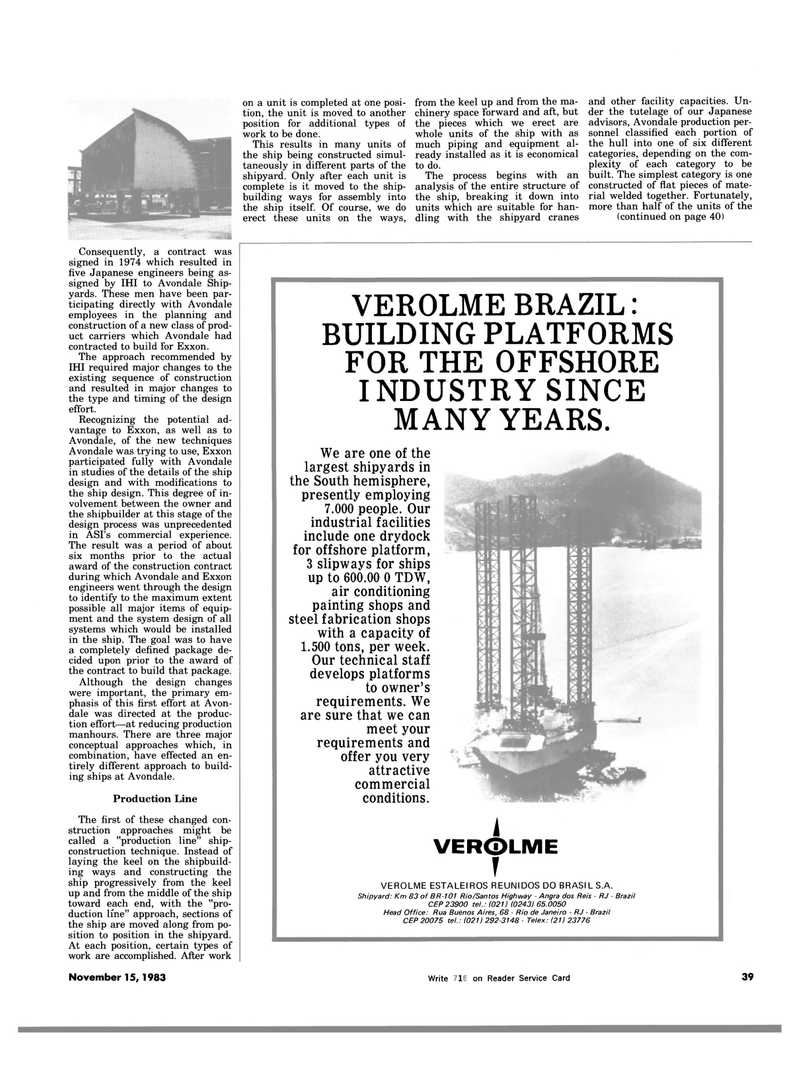
Page 39: of Maritime Reporter Magazine (November 15, 1983)
Read this page in Pdf, Flash or Html5 edition of November 15, 1983 Maritime Reporter Magazine
Consequently, a contract was signed in 1974 which resulted in five Japanese engineers being as- signed by IHI to Avondale Ship- yards. These men have been par- ticipating directly with Avondale employees in the planning and construction of a new class of prod- uct carriers which Avondale had contracted to build for Exxon.
The approach recommended by
IHI required major changes to the existing sequence of construction and resulted in major changes to the type and timing of the design effort.
Recognizing the potential ad- vantage to Exxon, as well as to
Avondale, of the new techniques
Avondale was trying to use, Exxon participated fully with Avondale in studies of the details of the ship design and with modifications to the ship design. This degree of in- volvement between the owner and the shipbuilder at this stage of the design process was unprecedented in ASI's commercial experience.
The result was a period of about six months prior to the actual award of the construction contract during which Avondale and Exxon engineers went through the design to identify to the maximum extent possible all major items of equip- ment and the system design of all systems which would be installed in the ship. The goal was to have a completely defined package de- cided upon prior to the award of the contract to build that package.
Although the design changes were important, the primary em- phasis of this first effort at Avon- dale was directed at the produc- tion effort—at reducing production manhours. There are three major conceptual approaches which, in combination, have effected an en- tirely different approach to build- ing ships at Avondale.
Production Line
The first of these changed con- struction approaches might be called a "production line" ship- construction technique. Instead of laying the keel on the shipbuild- ing ways and constructing the ship progressively from the keel up and from the middle of the ship toward each end, with the "pro- duction line" approach, sections of the ship are moved along from po- sition to position in the shipyard.
At each position, certain types of work are accomplished. After work
November 15, 1983 on a unit is completed at one posi- tion, the unit is moved to another position for additional types of work to be done.
This results in many units of the ship being constructed simul- taneously in different parts of the shipyard. Only after each unit is complete is it moved to the ship- building ways for assembly into the ship itself. Of course, we do erect these units on the ways, from the keel up and from the ma- chinery space forward and aft, but the pieces which we erect are whole units of the ship with as much piping and equipment al- ready installed as it is economical to do.
The process begins with an analysis of the entire structure of the ship, breaking it down into units which are suitable for han- dling with the shipyard cranes and other facility capacities. Un- der the tutelage of our Japanese advisors, Avondale production per- sonnel classified each portion of the hull into one of six different categories, depending on the com- plexity of each category to be built. The simplest category is one constructed of flat pieces of mate- rial welded together. Fortunately, more than half of the units of the (continued on page 40)
VEROLME BRAZIL:
BUILDING PLATFORMS
FOR THE OFFSHORE
INDUSTRY SINCE
MANY YEARS.
We are one of the largest shipyards in the South hemisphere, presently employing 7.000 people. Our industrial facilities include one drydock for offshore platform, 3 slipways for ships up to 600.00 0 TDW, air conditioning painting shops and steel fabrication shops with a capacity of 1.500 tons, per week.
Our technical staff develops platforms to owner's requirements. We are sure that we can meet your requirements and offer you very attractive commercial conditions. i VEROLME
T
VEROLME ESTALEI ROS REUNIDOS DO BRASILS.A.
Shipyard: Km 83 of BR-101 Rio/Santos Highway - Angra dos Reis - RJ - Brazil
CEP 23900 tel.: (021) 102431 65.0050
Head Office: Rua Buenos Aires, 68 - Rio de Janeiro - RJ - Brazil
CEP 20075 tel.: (021) 292-3148 - Telex: (21) 23776
Write 1001 on Reader Service Card 39

 38
38

 40
40
